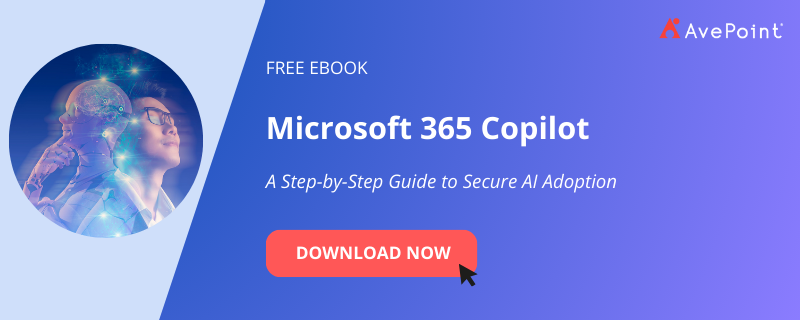Enhancing AI Training Programs for Organizational Success

Are your employees ready for artificial intelligence (AI)? Like any other groundbreaking technologies, AI is creating new opportunities, new jobs, and new approaches to optimize existing practices. While many view AI as a means to upgrade processes and enhance employee productivity, there are apprehensions when it comes to AI’s role in “augmenting versus replacing” jobs.
A new study from International Labour Organization (ILO) finds that generative AI is more likely to augment than destroy jobs by automating some tasks rather than taking over a role entirely. And organizations should focus more on how employees with freed-up time and capacity can create new business value and train them on skills required to thrive in a rapidly changing job market.
However, AvePoint’s AI & Information Management 2024 report highlights that only 46% of organizations offer AI-specific training, representing a significant gap between technology advancement and successful implementation through employee education and training. The AI skills gap is real and growing.
To fully embrace AI, organizations should adopt a comprehensive approach by upskilling their workforce for the future. Humans are essential in guiding technology implementation and its usage. Striking a good balance between human intelligence and AI is the driving force for an organization’s success.
Importance of AI Training Programs
Gartner research finds that 25% of organizations planned to deploy AI within the next 12 months every year from 2019 to 2024, yet the annual growth of production deployments was only 2% to 5%.
One explanation? Many organizations do not have the specific skills required to take full advantage of AI adoption, stalling deployments in their tracks. To proactively address any employee concerns on working with AI, training should be provided broadly across the organization — not only in IT or developers, but also in marketing, finance, and other departments. Creating a baseline knowledge of the benefits and risks of the technology and regularly implementing programs to assess organizational readiness are key to ensuring a smoother deployment.
From skeptics who rarely use AI to power users who use it extensively, most employees who struggle with the pace and volume of work say AI saves time, boosts creativity, and allows them to focus on more important tasks. In the 2024 Work Trend Index, over 90% of power users say AI makes their overwhelming workload more manageable and enjoyable.
Further, those who are seeing the benefits of using AI also are empowered to explore and experiment with this tool by their leadership. The Work Trend Index found AI power users are 61% more likely to have heard the importance of using generative AI at work from their CEO and 53% more likely to receive encouragement from leadership to consider how AI can transform their function.
Organizations that empower employees with AI tools and training will attract the best talent and have a competitive edge over those who are lagging behind in AI adoption.
Build a Future-Ready Workforce for AI Success
The first step is for organizations to define their AI best practices and strategies for safe use and adoption. Then, you can tailor deployment plans and training programs focused on ensuring employees understand the business goals. Rather than employees skilling up on their own which may put company data at risk, you can create a vision for what an “augmented workforce” looks like.

The AI & Information Management 2024 report suggests a two-pronged approach:
- AI literacy. Train employees on how AI systems function, its capabilities, and limitations, as well as the foundational and technical aspects of safe and secure AI usage. By providing practical, scenario-based learning experiences, employees can better understand how AI integrates into their specific roles and workflows, fostering more seamless adoption and maximizing the value derived from these technologies. They must grasp the mechanics behind AI decision-making processes to effectively interpret and apply the insights generated by these tools.
- Information literacy. Enable employees to discern between accurate information and AI biases, preventing erroneous output from influencing decision-making processes. By delving deeper into AI’s underlying principles, employees can critically evaluate information quality and integrity, identify information needs, and extract valuable insights. They must ensure that decisions are grounded in both data-driven insights and contextual understanding, which require not just technical proficiency but also expertise and judgment.
These two approaches allow employees to enhance their proficiency in AI tools and be better stewards of its output. By empowering employees to navigate AI safely and efficiently, organizations not only mitigate the risk of erroneous output but also cultivate continuous learning and adaptation, which are essential for long-term organizational success.
Track AI Adoption Trends to Enhance Employee Training
Employee AI training is not a one-and-done process; organizations need to consistently assess how and when tasks are performed, who is performing them, how long tasks typically take, and how critical different tasks are. Tracking usage trends and adoption metrics can further enhance training efforts to navigate complexities of AI and challenges within your workforce.
For example, if tracking reveals that AI is underutilized in certain departments, additional tailored training can be provided to address their pain points. These insights and analytics allow organizations to identify what kind of training is needed and define the process for refinement and optimization based on real-world experiences.
Organizations can also have a pilot group of power users to report their use cases before a full launch or leverage a tool like AvePoint tyGraph, which now includes analytics for Microsoft 365 Copilot adoption. AvePoint tyGraph is an advanced analytics and reporting tool that supports organizations in unlocking the full potential of their AI investments. With valuable data-driven intelligence on how users leverage Microsoft’s AI-powered productivity tool, organizations can measure employee experience by tracking adoption trends, pinpointing untapped opportunities for increased engagement, and identifying areas of improvement to build training around.

Conclusion
AI will not replace humans, but humans with AI skills could potentially replace humans who do not possess this knowledge. By investing in AI and information literacy, organizations can ensure their employees have the right knowledge and understanding of AI to be responsible practitioners.
Comprehensive AI training programs are not only a necessity but also a strategic imperative for organizations aiming to thrive in an AI-driven world. Training programs must be well thought out to nurture a highly skilled workforce to use AI tools responsibly and effectively, while also reducing the risk of bad output and producing more valued insights.
AI can empower people — but only if organizations take a broad view of its capabilities and deeply consider productivity improvements and business implications. Leverage reporting tools and enablement programs to help better understand the current and future needs to enhance employee experience and determine how best to redeploy and upskill your workforce.
With AI ever evolving, there is no time to sit back and learn from others — invest in your employees today!
Take a step toward secure and successful AI adoption. Download free eBook: Microsoft 365 Copilot: A Step-by-Step Guide to Secure AI Adoption

Amabel Palencia is a content specialist at AvePoint, covering information lifecycle management and artificial intelligence (AI). A journalism graduate, she has 15+ years of experience in project management, customer engagement, communications, and content marketing strategy for B2B campaigns.



